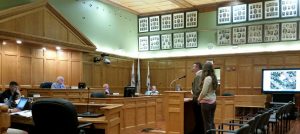WESTFIELD—The proposed water treatment facility completed another step in its creation yesterday, gaining approval from the Westfield Planning Board.
The planning board voted unanimously to recommend approval of the special and stormwater management permits for the water treatment facility that will be located on Owen District Road. The facility, if constructed, will be used to help treat the city’s water for the contamination of perfluorinated compounds (PFCs), which has resulted in two of the city’s wells being offline since January 2016.
The plans have previously gone before other committees, including the Conservation Commission and the Barnes Aquifer Protection Advisory Committee (BAPAC), who made suggestions for the project, a number of which were associated into the plan.
The treatment facility, according to Heather Miller, water systems engineer for the city who was present at the meeting, will be located “near existing well seven off of Owen District Road,” which is near the East Mountain Country Club in the city.
Well seven, along with nearby well eight, were the two wells taken offline in January 2016, after the levels of PFCs found within them were beyond the Environmental Protection Agency’s lifetime advisory limit.
The site will be a 4,100 square-foot facility, “with about 16,000 square feet of impervious ground around it,” according to Miller. The ground will be covered with porous paving, according to Miller, which may assist in the filtration of stormwater to groundwater and was based off discussion with BAPAC.
The site will be host to granular-activated carbon (GAC) filters, which are used to extract the PFCs from the water. These filters are expected to be able to last for at least a year, as revealed by previous bench-scale testing done by the city.
These filters may be changed after a year and will be done at the site with trucks.
According to Alan G. LeBlanc, associate for CDM Smith, the company who helped design the plan, the site will also be housing two chemicals, one for equipment and one for water disinfection. LeBlanc said that phosphate will be used on site and stored there to prevent corrosion, while sodium hydrochloride will be used for disinfection.
He also said that no diesel fuel will be used on site, but instead natural gas will be connected to the site through Westfield Gas and Electric. This will be connected to a generator and transformer on site, that will sit atop a concrete pad that has a lip to reduce chance of contamination in the case of a spill.
The site is expected to be unmanned but there will be computer systems monitoring the site, and according to LeBlanc, there will be regular checks by city employees at the site. In addition, public access is not allowed in the area.
“General public will not being going down there hardly ever,” LeBlanc said.
There was also a suggestion made by BAPAC related to a composting toilet that could be installed at the site, but according to Miller, the city has decided to go with a traditional bathroom in lieu of a composting toilet.
Miller said that they want any waste to be 400 feet away from the well nearby, and with a composting toilet this could not be done.
The bathroom would require a septic system to be installed, which would be 400 feet from the well.
According to Dave Billips, director of the Department of Public Works, the proposal is due to the need for something more permanent at the site for those who will work there at times.
In addition, he said that other water treatment facilities, including those on Southwick Road and Shaker Road locations, also have bathrooms.


